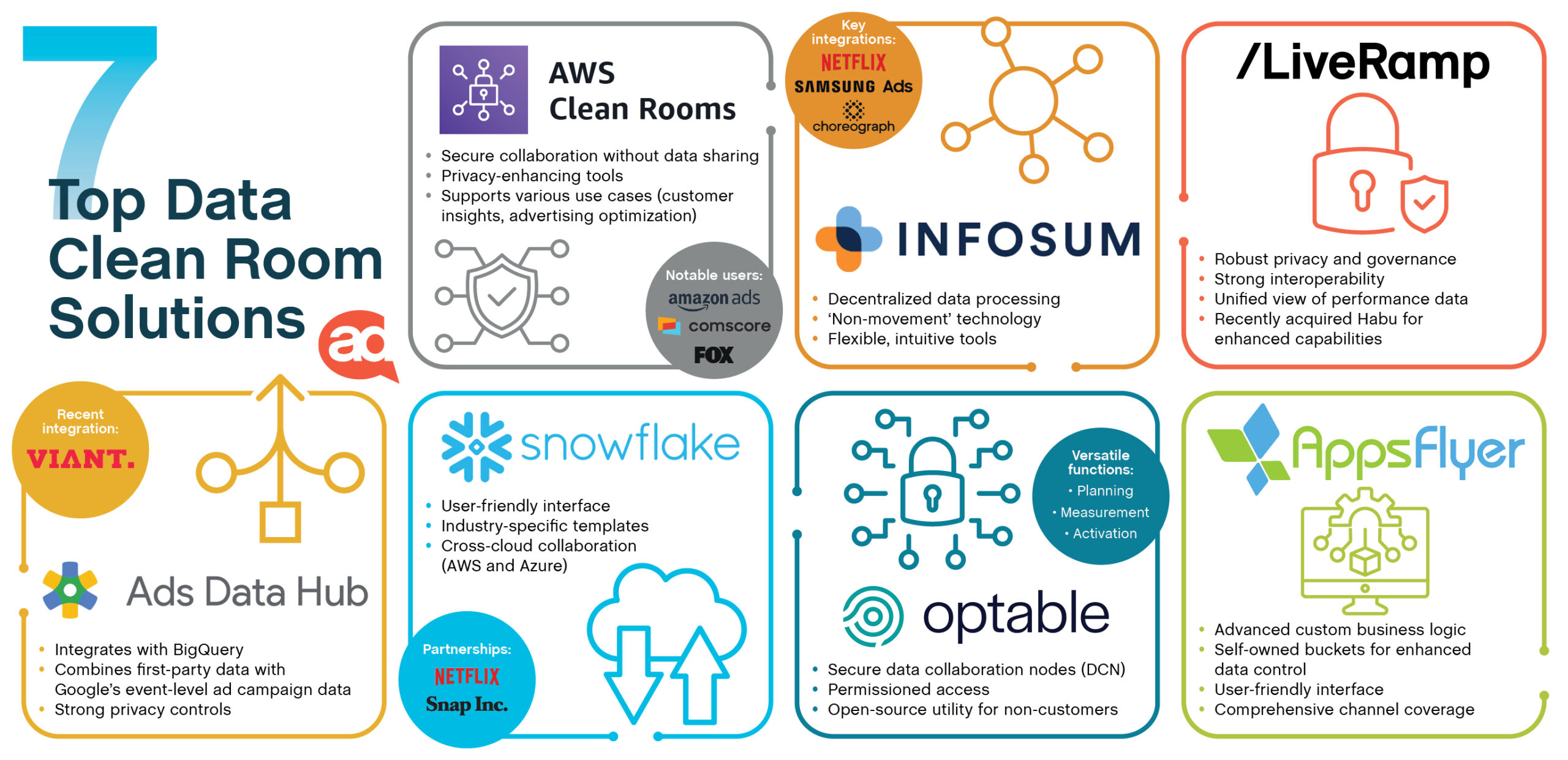
Privacy-enhancing technologies are essential tools for marketers, and Data Clean Rooms are one of many PET solutions. They provide a way to analyze sensitive data securely while preserving privacy. But how do you decide which solutions are best for your business?
You must dig deep into each PET solution, to decide which works best for your business goals. For instance, how do you decide which Data Clean Rooms (DCR) fits best?
DCRs offer a way to analyze sensitive data without compromising privacy or security. Myles Younger, Head of Innovation and Insights at U of Digital, likens them to a pivot table in Excel; data clean rooms grant users access to insights from large datasets without directly accessing the underlying raw data. This ensures that PII remains secure while enabling detailed analysis and actionable insights.
As Younger points out, the key to success lies in how companies use clean rooms to drive client value. “Advertisers want what they’ve always wanted: new ideas, insights, and clear performance measurement,” he explains.
Therran Oliphant, an advisor at Thirdwave and AdMonsters Advisory Board Member, adds that publishers are evaluating data clean rooms with more sophistication as they consider factors such as decentralization, privacy, and data orchestration. He points out that the ability to keep first-party data on-premise, without moving it into cloud environments, is crucial for many publishers and their ad ops teams.
This decentralized approach allows them to retain full control over their data while leveraging the clean room’s tools to share only non-personal insights, ensuring both data safety and effective marketing execution. When used correctly, DCRs bridge the gap between performance optimization and data security, making them a vital part of the future of digital marketing.
We took a deep dive to discover seven of the top Data Clean Room solutions to help you find the perfect fit for elevating your business’s data strategy.
7 Top Data Clean Room Solutions
AWS Clean Rooms
Amazon’s Data Clean Room solution, AWS Clean Rooms offers a secure solution for companies to collaborate with partners on data analysis without sharing or duplicating sensitive information. By setting up a clean room in just a few steps, businesses can securely work with other companies on AWS, using privacy-enhancing tools to protect their data.
AWS Clean Rooms supports a range of use cases, from improving customer insights and optimizing advertising to enhancing reporting and research. Clients like Fox, Comscore, and Amazon Ads use this platform to unlock valuable insights while safeguarding data privacy.
According to Adam Solomon, Global Head of Business Development and Go-to-Market for AWS Clean Rooms, AWS sees itself as a facilitator, enhancing data clean rooms’ capabilities by enabling secure data sharing without moving it between platforms.
AWS exemplifies this through partnerships with The Weather Channel and Lotame to enable faster and safer insight generation. Rather than competing directly with data clean room providers like Habu or InfoSum, their ultimate goal is to provide foundational privacy-enhancing technologies for others to build on.
InfoSum
InfoSum’s data clean room solution offers data protection and seamless collaboration through a match system that allows companies to analyze multiple datasets without moving or sharing data. Through decentralized data processing and patented ‘non-movement’ technology, InfoSum ensures that sensitive information remains private, eliminating data exposure or misuse risks.
This privacy-first approach supports a range of data-driven strategies, such as audience planning, activation, and measurement, while providing superior speed and efficiency, even in multi-party collaborations. Its flexible, intuitive tools allow marketers to control their data processes without specialized technical expertise.
One of InfoSum’s key features is its ability to boost match rates by integrating with any identity provider, enabling seamless crosswalks and transparent match testing across multiple datasets. By connecting data silos both internally and with external partners, businesses can unlock valuable consumer insights and enhance targeting and personalization.
What are some of their most prominent integrations? Netflix, Samsung Ads, and WPP’s data and tech platform Choreograph which is run mostly through GroupM.
LiveRamp (and Habu)
LiveRamp’s data clean room technology provides companies with a secure environment to use and share data while maintaining consumer privacy. One of its key features is robust privacy and governance, which ensures data protection, giving media companies confidence in the safety of their information.
LiveRamp’s data clean room offers strong interoperability, allowing marketing organizations a seamless connection to their partners (CTV providers like Amazon, Facebook, and Google.) Liveramp designed the platform for ease of use, making it accessible for marketers to analyze campaigns across multiple channels, including TV, CTV, and social media.
By offering a unified view of performance data across all advertising channels, LiveRamp enables marketers to draw holistic insights, enhancing their strategic collaborations. Furthermore, it allows them to maximize every customer touchpoint, optimizing engagement.
LiveRamp recently acquired Habu to assist with accelerating data collaboration with enhanced clean room tech. This is the industry’s only interoperable platform for seamless data sharing across all clouds and walled gardens.
Google Ads Data Hub
Google Ads Data Hub integrates with BigQuery to combine first-party data with Google’s event-level ad campaign data, providing valuable insights enhancing advertising efficiency and optimize campaigns. It ensures user privacy by grouping results over multiple users and implementing robust privacy checks.
The platform supports access to Google, mobile device, and publisher-specific user IDs for comprehensive campaign analysis while maintaining strong privacy controls. Enhanced audience building and management capabilities are available for integration with other Google Ad products.
BigQuery Data Clean Rooms offers a secure, privacy-focused solution for managing and analyzing data without duplication. It helps publishers refine audience targeting, comply with privacy regulations, and collaborate efficiently with partners. With quick deployment through Google Cloud Console or APIs, it supports real-time updates and provides aggregated metrics for data-driven decisions.
Their most recent integration with DSP, Viant Technologies, allows seamless onboarding of privacy-safe first-party data into Viant’s Data Platform, enhancing targeting and measurement capabilities.
Snowflake
Snowflake Data Clean Rooms, launched following Snowflake’s acquisition of Samooha in December 2023, integrates advanced data clean room technology into the Snowflake ecosystem.
Now available through the Snowflake Marketplace, this offering simplifies setting up and using data clean rooms without incurring additional access fees. Snowflake Data Clean Rooms provide a user-friendly interface and industry-specific templates, allowing organizations to efficiently collaborate on sensitive data while maintaining strict privacy and governance standards.
To overcome the traditional barriers of data clean room deployment Snowflake designed its Data Clean Rooms solution, making it accessible to companies of all sizes. It facilitates secure, cross-cloud collaboration across AWS and Azure, and integrates seamlessly with Snowflake’s open data cloud ecosystem. By leveraging Snowpark for AI/ML and other built-in privacy features, Snowflake ensures that sensitive data remains within its secure environment while enabling deeper analytical insights.
In addition, they have partnerships with Netflix and Snap.
Optable
Optable’s data clean rooms offer secure environments where multiple parties collaborate on data while keeping the underlying data private and intact.
These clean rooms ensure that each participant maintains control over their data. Key features include permissioned access, where all parties must consent to any operations, and built-in privacy protections to safeguard information. Optable provides each customer with a secure data collaboration node (DCN) to store their data, and they can configure the connectivity and information transfer level within their own DCN.
Additionally, non-customers can download an open-source utility to manage their data independently. Optable’s versatile data clean rooms support various functions such as planning, measurement, and activation.
AppsFlyer Data Clean Room
AppsFlyer’s Data Clean Room offers a distinctive advantage with its advanced custom business logic and self-owned buckets. The custom business logic feature allows users to run tailored queries within the clean room, providing precise insights specific to their marketing needs. The self-owned buckets enhance data control by enabling users to manage data upload, integration, and access permissions independently, ensuring that all data handling aligns with their unique requirements and privacy standards.
Moreover, AppsFlyer’s Data Clean Room simplifies the reporting process with its user-friendly interface and automated report configuration. This solution streamlines BI tasks and ensures compliance with stringent privacy regulations like GDPR and CCPA.
This clean room also encompasses a wide range of channels to provide a comprehensive view of your marketing efforts. This includes digital channels such as social media, search engines, display advertising, and video platforms. By integrating data from these diverse sources, the clean room allows you to gain a holistic perspective on campaign performance and optimize strategies across all your marketing channels while maintaining stringent privacy standards.
Debunking the Myths Around Data Clean Rooms
If you are hesitant to try out data clean rooms, Younger urges you to let go of your misconceptions.
The biggest misconception about data clean rooms is that their use cases are new or unclear. In reality, most have been around for decades, such as publisher audience segmentation, advertiser audience onboarding, and event matching for post-campaign attribution. Data clean rooms simply represent the latest, most secure way to execute these longstanding processes with enhanced privacy protections.
“We work with ad tech companies and platforms across the industry, and the ones that seem poised for success are the ones that are positioning clean rooms as unlocks for client success, not as technical marvels,” says Younger.
And for some experts, data clean rooms, or data collaboration as a more broad practice, will be a large foundation to uphold the industry. This is especially true as we shift toward first-party data assets as the prominent cornerstone of digital marketing strategies in a privacy-first world.
